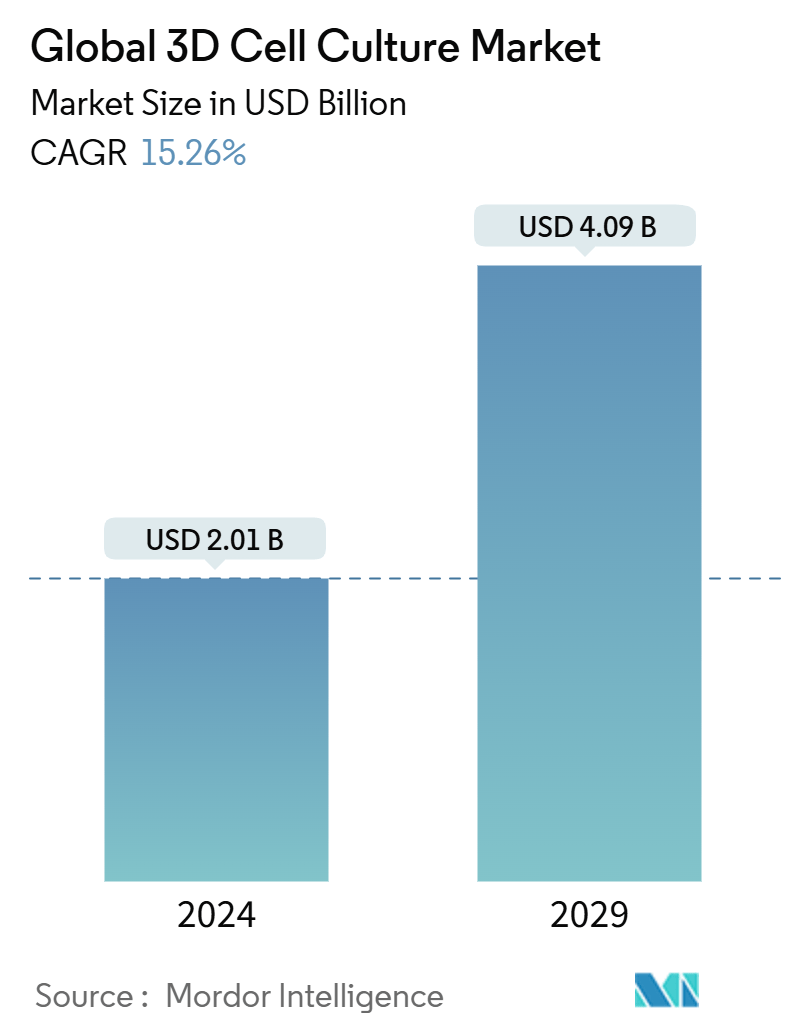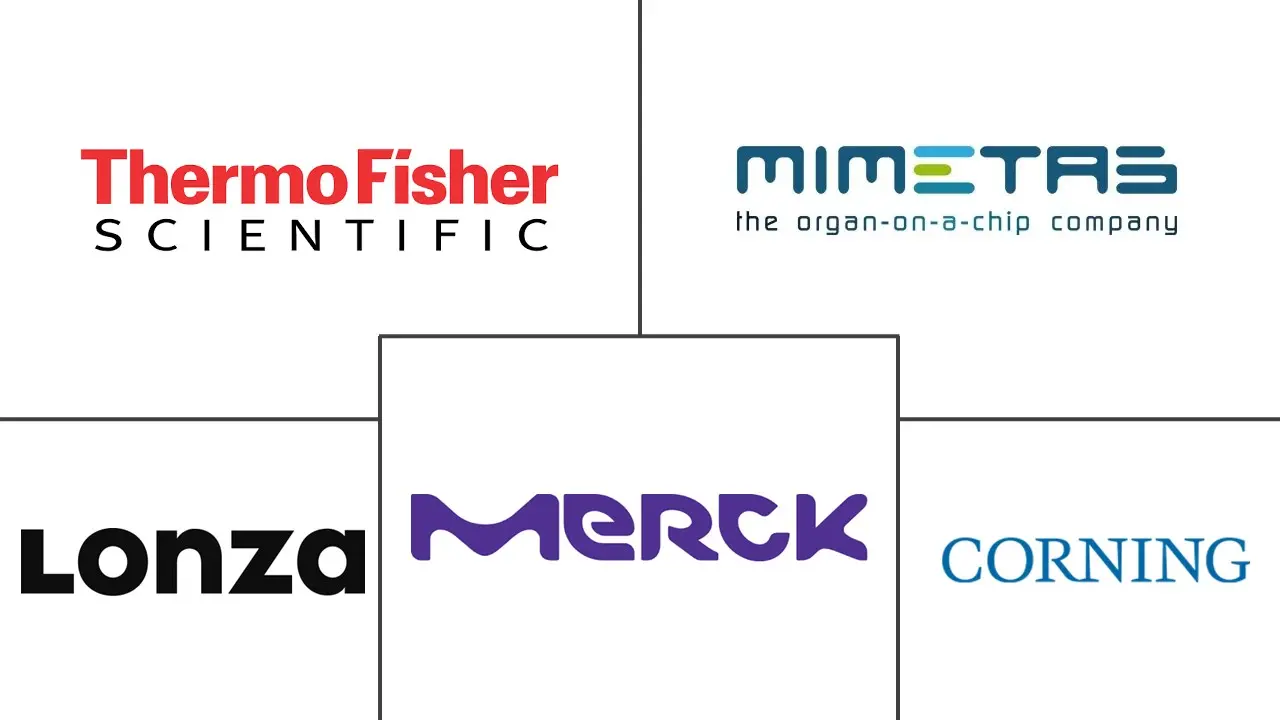
| Study Period | 2019 - 2029 |
| Market Size (2024) | USD 2.01 Billion |
| Market Size (2029) | USD 4.09 Billion |
| CAGR (2024 - 2029) | 15.26 % |
| Fastest Growing Market | Asia-Pacific |
| Largest Market | North America |
| Market Concentration | Medium |
Major Players
*Disclaimer: Major Players sorted in no particular order |
3D Cell Culture Market Analysis
The Global 3D Cell Culture Market size is estimated at USD 2.01 billion in 2024, and is expected to reach USD 4.09 billion by 2029, at a CAGR of 15.26% during the forecast period (2024-2029).
The 3D cell culture market is witnessing stable growth due to factors like the use of 3D cell culture models as alternative tools for in vivo testing, the development of large-scale automated cell culture systems, and the rising need for organ transplantation. The 3D cell culture and co-culture models have huge benefits since they not only enable drug safety and efficacy assessment in a more in vivo–like context than traditional 2D cell cultures, but they can also eliminate the species differences that pose limitations in the interpretation of the preclinical outcomes by allowing drug testing directly in human systems.
Additionally, with the increase in demand for organ transplantation, there is likely to be a demand for 3D cell cultures as there is a need to recapitulate complex aspects of human physiology, pathology, and drug responses in vitro. According to the United States Health Resources and Services Administration, in March 2024, 103,223 patients were on the national organ transplant waiting list for the year 2023. Data from the website also states that more than 46,000 transplants were performed in 2023 in the United States. Thus, the increase in organ transplants is increasing the demand for research models where 3D cell cultures are used. This is expected to boost the market's growth.
The 3D cell culture system is crucial for developing organoids and functional tissue constructs, which are vital for transplantation and drug response analysis. Additionally, companies are introducing products that significantly enhance tissue culture and tissue engineering applications are expected to increase demand for the 3D cell culture products is anticipated to boost the market over the forecast period. For instance, in June 2023, 3D BioFibR launched two new collagen fiber products for 3D bioprinting: the CollaFibR 3D scaffold and μCollaFibR, both designed to improve 3D cell culture methods.
Furthermore, product launches by the market players are expected to propel the growth of the market. For instance, in August 2024, CytoNest Inc., a startup from the University of Georgia, launched its inaugural commercial product: the CytoSurge 3D fiber scaffold. This innovative fiber scaffold enhances cell manufacturing and tissue engineering. With its versatile applications, the CytoSurge 3D fiber scaffold is poised to make significant contributions to cell research, biopharmaceuticals, cell therapeutics, and the development of cultured meat and seafood. Similarly, in October 2024, CD Bioparticles unveiled its latest innovation: a 3D Cell Culture Substrate tailored for tissue engineering scaffold research. This biocompatible, three-dimensional matrix empowers researchers to craft precise models, enhancing studies on cell behavior, drug screening, and tissue engineering.
Due to the increasing rates of organ transplantation and strategic initiatives by market players, the cell culture market is projected to experience substantial growth during the forecast period. However, a shortage of skilled and experienced professionals may impede this market expansion.
3D Cell Culture Industry Segmentation
As per the scope of the report, 3-dimensional (3D) cell culture is an artificially created environment in which biological cells are permitted to grow or interact with their surroundings in all three dimensions. The 3D cell culture market is segmented by product, application, end-user, and geography. By product, the market is segmented as scaffold-based 3D cell cultures, scaffold-free 3D cell cultures, microchips, and 3D Bioreactors. By application, the market is segmented as drug discovery, tissue engineering, clinical applications, and other applications. By end user, the market is segmented as research laboratories and institutes, biotechnology and pharmaceutical companies and other end users. By geography, the market is segmented as North America, Europe, Asia-Pacific, Middle-East and Africa, and South America. The market report also covers the estimated market sizes and trends for 17 countries across major regions globally. The report offers the value (in USD) for the above segments.
| Scaffold-based 3D Cell Cultures | Micropatterned Surface Microplates |
| Hydrogels | |
| Other Products | |
| Scaffold-free 3D Cell Cultures | Hanging drop microplates |
| Microfluidic 3D cell culture | |
| Other Products | |
| Microchips | |
| 3D Bioreactors |
| Drug Discovery |
| Tissue Engineering |
| Clinical Applications |
| Other Applications |
| Research Laboratories and Institutes |
| Biotechnology and Pharmaceutical Companies |
| Other End Users |
| North America | United States |
| Canada | |
| Mexico | |
| Europe | Germany |
| United Kingdom | |
| France | |
| Italy | |
| Spain | |
| Rest of Europe | |
| Asia-Pacific | China |
| Japan | |
| India | |
| Australia | |
| South Korea | |
| Rest of Asia-Pacific | |
| Middle East and Africa | GCC |
| South Africa | |
| Rest of Middle East and Africa | |
| South America | Brazil |
| Argentina | |
| Rest of South America |
Global 3D Cell Culture Market Size Summary
The 3D cell culture market is experiencing robust growth, driven by its application as an alternative to traditional 2D cultures and animal models in drug development and research. This market is gaining traction due to the ability of 3D cell cultures to mimic human physiology more accurately, which is crucial for drug safety and efficacy assessments. The COVID-19 pandemic has further accelerated the adoption of 3D cell cultures, as they offer a more relevant model for studying viral infections and testing potential therapies in a physiological microenvironment. The demand for organ transplantation is also contributing to market expansion, as 3D cell cultures are essential for recapitulating complex human physiological and pathological responses in vitro. The integration of microchip technologies with 3D cell cultures is enhancing real-time analysis capabilities, thereby boosting the market's growth prospects.
North America, particularly the United States, dominates the 3D cell culture market, supported by significant investments in research and development and technological advancements in the region. The presence of major players such as Corning Incorporated, Lonza AG, Merck KGaA, and Thermo Fisher Scientific intensifies the competitive landscape. These companies are actively expanding their portfolios and developing innovative solutions to meet the growing demand for 3D cell culture technologies. The market is characterized by continuous advancements and the introduction of new products, such as Amerigo Scientific's expanded cell culture portfolio and Jellagen Limited's JellaGel Hydrogel, which cater to various research applications. As the need for more accurate and efficient research models continues to rise, the 3D cell culture market is poised for sustained growth.
Global 3D Cell Culture Market Size - Table of Contents
1. MARKET DYNAMICS
- 1.1 Market Overview
-
1.2 Market Drivers
- 1.2.1 Use of 3D Cell Culture Models as Alternative Tools for In Vivo Testing
- 1.2.2 Development of Automated Large-scale Cell Culture Systems
- 1.2.3 Rising Need for Organ Transplantation
-
1.3 Market Restraints
- 1.3.1 Lack of Experienced and Skilled Professionals
- 1.3.2 Budget Restriction for Small- and Medium-sized Laboratories
-
1.4 Porter's Five Forces Analysis
- 1.4.1 Threat of New Entrants
- 1.4.2 Bargaining Power of Buyers/Consumers
- 1.4.3 Bargaining Power of Suppliers
- 1.4.4 Threat of Substitute Products
- 1.4.5 Intensity of Competitive Rivalry
2. MARKET SEGMENTATION (Market Size by Value – USD)
-
2.1 By Product
- 2.1.1 Scaffold-based 3D Cell Cultures
- 2.1.1.1 Micropatterned Surface Microplates
- 2.1.1.2 Hydrogels
- 2.1.1.3 Other Products
- 2.1.2 Scaffold-free 3D Cell Cultures
- 2.1.2.1 Hanging drop microplates
- 2.1.2.2 Microfluidic 3D cell culture
- 2.1.2.3 Other Products
- 2.1.3 Microchips
- 2.1.4 3D Bioreactors
-
2.2 By Application
- 2.2.1 Drug Discovery
- 2.2.2 Tissue Engineering
- 2.2.3 Clinical Applications
- 2.2.4 Other Applications
-
2.3 By End User
- 2.3.1 Research Laboratories and Institutes
- 2.3.2 Biotechnology and Pharmaceutical Companies
- 2.3.3 Other End Users
-
2.4 Geography
- 2.4.1 North America
- 2.4.1.1 United States
- 2.4.1.2 Canada
- 2.4.1.3 Mexico
- 2.4.2 Europe
- 2.4.2.1 Germany
- 2.4.2.2 United Kingdom
- 2.4.2.3 France
- 2.4.2.4 Italy
- 2.4.2.5 Spain
- 2.4.2.6 Rest of Europe
- 2.4.3 Asia-Pacific
- 2.4.3.1 China
- 2.4.3.2 Japan
- 2.4.3.3 India
- 2.4.3.4 Australia
- 2.4.3.5 South Korea
- 2.4.3.6 Rest of Asia-Pacific
- 2.4.4 Middle East and Africa
- 2.4.4.1 GCC
- 2.4.4.2 South Africa
- 2.4.4.3 Rest of Middle East and Africa
- 2.4.5 South America
- 2.4.5.1 Brazil
- 2.4.5.2 Argentina
- 2.4.5.3 Rest of South America
Global 3D Cell Culture Market Research Faqs
How big is the Global 3D Cell Culture Market?
The Global 3D Cell Culture Market size is expected to reach USD 2.32 billion in 2025 and grow at a CAGR of 15.26% to reach USD 4.71 billion by 2030.
What is the current Global 3D Cell Culture Market size?
In 2025, the Global 3D Cell Culture Market size is expected to reach USD 2.32 billion.


